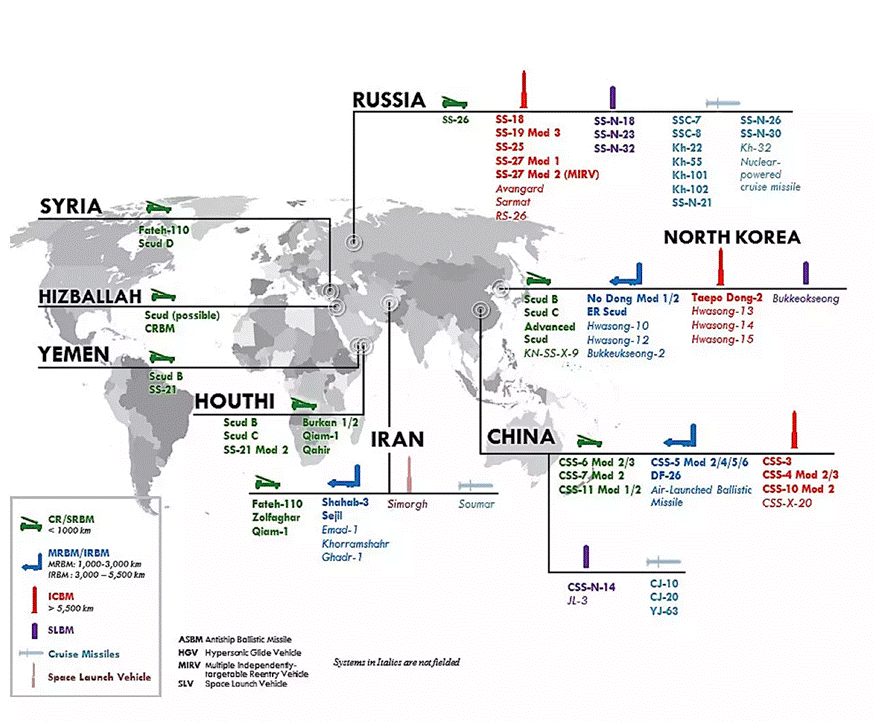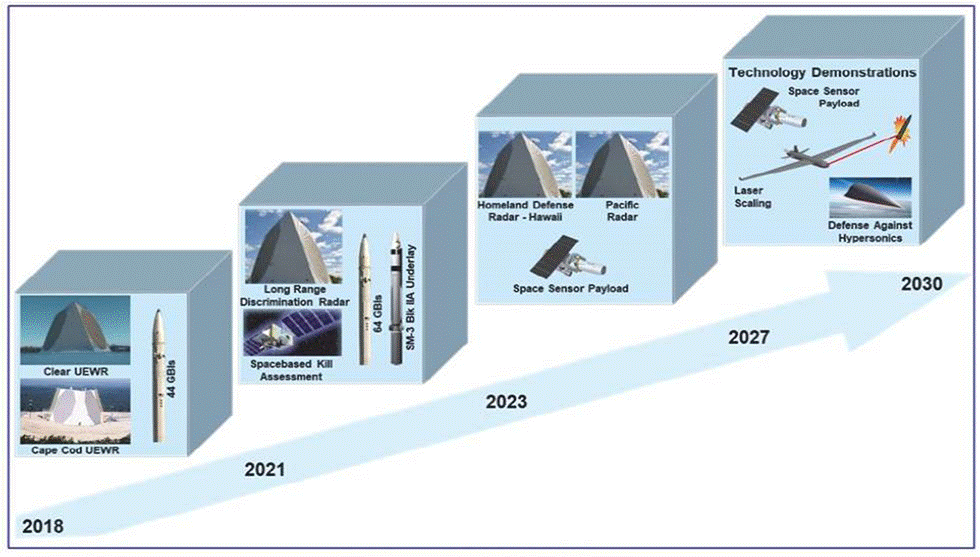
Here's All You Need To Know About The New Missile Defense Review That Was Just Released
The report gives all new emphasis to cruise missile and hypersonic threats and further outlines plans for new defenses, including in space. BY JOSEPH TREVITHICKJANUARY 17, 2019
新ミサイル防衛レビュー大全
報告書は巡航ミサイルと極超音速の脅威にすべての新たな強調を与えて、さらに宇宙でを含む新しい防御の計画を概説します。
【WarZone】2019年1月17日、JOSEPH TREVITHICK
After more than a year of delays, the U.S. military has finally released its long-awaited Missile Defense Review.
The report outlines plans to improve and expand the United States' existing missile defense shield, as well as add additional layers with space-based sensors and interceptors, technology to track and defeat hypersonic weapons, unmanned aircraft with lasers to shoot down threats, and missile-hunting F-35 stealth fighters, among others.
1年以上の遅れた後、米軍はついにその待望のミサイル防衛レビューを発表しました。レポートは、米国の既存のミサイル防衛シールドを改良して拡大する計画、ならびに宇宙空間のセンサーと迎撃装置、極超音速兵器を追跡し撃破する技術、脅威を撃墜するためのレーザーを備えた無人航空機、およびミサイルを追加とりわけF-35ステルス戦闘機を活用する。
The Pentagon officially released the unclassified version of the review at a rollout event led by President Donald Trump, who has become a major advocate for missile defense, a well as Vice President Mike Pence, National Security Adviser John Bolton, Acting Secretary of Defense Patrick Shanahan, and other senior officials, on Jan. 17, 2019. The U.S. military had originally expected this report to be ready before the end of 2017.
米国防総省は、ミサイル防衛の主要な推進者となったドナルド・トランプ大統領、国防総省副長官、ジョン・ボルトン副大統領、防衛長官のパトリック・シャナハンが率いるロールアウト・イベントで、非機密扱いのレビューを正式に発表した。米軍はもともとこの報告書が2017年末までに作成されることを期待していた。
"Missile defenses are a key element of our strategy given this proliferation of offensive ballistic and cruise missiles and emerging hypersonic weapons technologies that markedly raise threats to regional balances and to our major allies and partners," Acting Secretary of Defense Shanahan wrote in a preface to the review.
"Our missile defense systems constitute a cornerstone of our efforts to deter a missile attack by a rogue state on the U.S. and make a clear contribution to our alliances."
「攻撃的な弾道ミサイルと巡航ミサイル、そして地域のバランスと主要な同盟国とパートナーに対する脅威を著しく高める新たな極超音速兵器技術のこの拡散を考えると、ミサイル防衛は私たちの戦略の重要な要素です。」
国防長官代理シャナハンは、レビューの序文に 「私たちのミサイル防衛システムは、米国への不正国家によるミサイル攻撃を阻止し、私たちの同盟に明確な貢献をするという私たちの努力の要である」と語った。
Given how long it's taken for the Pentagon to release the final review, the bulk of the content has already emerged in budget documents and other public forums. Still, the report further cements the U.S. governments intention to pursue these policies and technologies and we've broken down the key points below:
ペンタゴンが最終レビューを発表するのにどれぐらいの時間がかかるかを考えると、大部分のコンテンツはすでに予算文書や他の公開フォーラムに現れています。
それでも、レポートはこれらの方針と技術を追求するという米国政府の意図をさらに固めており、我々は以下の要点をまとめました:
■Policy priorities 政策方針の優先度
U.S. Missile Defense Shield remains focused primarily on countering threats from smaller potential opponents, such as North Korea and Iran.
米国のミサイル防衛用のシールド(盾:主要兵器)は、依然として北朝鮮やイランのようなより小さな潜在的な敵からの脅威に対抗することに主眼を置いています。
Traditional nuclear deterrence remains the primary means of responding to existing and future strategic threats from larger potential adversaries such as Russia and China.
ロシアや中国など、より大きな潜在的な敵からの既存および将来の戦略的脅威に対応するには伝統的な核抑止力に、依然として頼っています
The U.S. government has no plans to limit developments of missile defense technologies to focus purely on smaller actors.
米国政府は、ミサイル防衛技術の開発を、より小規模な主体に焦点を当てることに限定するつもりはありません。
The Missile Defense Shield is a component of an over-arching deterrent posture in that it helps ensure the ability of the United States to respond to a massive attack on the homeland.
それが祖国への大規模攻撃に応じるアメリカ合衆国の能力を確実にするのを助けるという点で、ミサイルデフェンスシールドは全てにかかわる包括的抑止姿勢の構成要素です。
There is also a call for continued and expanded regional focuses, as well, including greater cooperation and coordination with allies and partners, especially in the face of the growing proliferation of ballistic missiles.
特に弾道ミサイルの急増に直面して、同盟国およびパートナーとの一層の協力と調整を含んでいる継続して拡大された地域的焦点も同様に求められている。
The MDR has requirements for various components of the U.S. military to complete a number of studies within the next six months to better formalize and streamline command and control and identify services or other agencies within the Department of Defense to lead efforts to respond to particular threats.
MDRは、特定の脅威に対応するための取り組みを主導するため米国軍または国防総省内の他の機関のいろいろな構成要素に対して今後6か月以内に多数の調査を実施し、司令および統制を強化し合理化する
The new MDR adds an entirely new emphasis on potential non-ballistic threats posed to the homeland and to U.S. forces deployed abroad, with particular attention on cruise missiles.
新しいMDRは、故国と海外に配備された米軍にもたらされる潜在的な非弾道兵器の脅威、特に巡航ミサイルを全く新しい重点項目として加える。
The 2010 MDR focused almost exclusively on ballistic threats.
2010年MDRはほぼ独占的に弾道の脅威に焦点を当てた。
■Near-term technical developments 短期的な技術開発
Expanding the SM-3 Block II interceptor's capabilities to allow it to engage intercontinental ballistic missiles, or ICBMs, as well as intermediate- and medium-range ballistic missiles, or IRBMs and MRBMs.
SM-3 Block II迎撃機の機能を拡張して、大陸間弾道ミサイル(ICBM)、中距離弾道ミサイル、中距離弾道ミサイル(IRBM、MRBM)を迎撃可能にします。
At present, the SM-3 Block IIA is primarily focused on engaging IRBM and MRBM type threats, though the Missile Defense Agency has long indicated its hope that it would also be able to conduct mid-course intercepts against higher and faster-flying targets.
現時点では、より高くてより速く飛んでいる目標に対してミッドコース迎撃を実行することもできるという望みをMissile防衛庁が長く示したけれども、SM-3 Block IIAは主に係合IRBMとMRBMタイプの脅威に集中します。
Add 20 more Ground-Based Interceptors (GBI) to the overall Ground-based Midcourse Defense (GMD) portion of the U.S. Missile Defense Shield, which is situated in Alaska, for a total of 64.
アラスカにある米国ミサイル防衛シールドの地上ベースのミッドコースディフェンス(GMD)部分にさらに20個の地上ベースの迎撃装置(GBI)を追加して、合計64個にします。
The purchase of these interceptors has been planned for some time and were first included in a request emergency missile defense funding that the Trump Administration sent to Congress in 2017.
これらの迎撃装置の購入はしばらく前から計画されており、トランプ政権が2017年に議会に送った要請緊急ミサイル防衛資金に最初に含まれた。
Continue development of the Redesigned Kill Vehicle, or RKV, to replace the existing Exoatmospheric Kill Vehicle, or EKV, on top of the GBI.
GBIの上にある既存のExoatmospheric Kill Vehicle(EKV)を置き換えるために、再設計されたKill Vehicle(RKV)の開発を続けます。
Previous reports have indicated that the U.S. military will begin deploying RKV-equipped interceptors in 2020.
これまでの報告によると、米軍は2020年にRKV装備の迎撃機の配備を開始する予定です。
The RKV, like the EKV, is a kinetic weapon designed to destroy an incoming ballistic missile by smashing into it.
RKVは、EKVと同様に、入ってくる弾道ミサイルを粉砕して破壊するように設計された動的武器です。
The EKV has struggled in testing since the late 1990s and only intercepted a target representative of an intercontinental ballistic missile for the first time in May 2017.
EKVは1990年代後半からテストに苦労しており、2017年5月に初めて大陸間弾道ミサイルの標的代表を迎撃しました。
Installation of Lockheed Martin's advanced Long Range Discrimination Radar (LRDR) in Alaska to support the GMD system. This radar is set to be operational by 2021.
GMDシステムをサポートするために、アラスカ州でロッキードマーチンの高度長距離識別レーダー(LRDR)を設置。このレーダーは2021年までに運用可能になる予定です。
Improving existing land-based radars and adding additional sites in Hawaii and elsewhere in the Pacific by 2023.
2023年までに、既存の陸上レーダーを改良し、ハワイやその他の太平洋地域にサイトを追加する。
These new radars will have improved capability to spot and track ballistic missiles during the mid-course portion of their flight trajectory when they have "gone cold" in the vacuum of space and are harder to monitor.
これらの新しいレーダーは、それらが宇宙の真空の中で「冷たくなった」ときに弾道ミサイルを発見し追跡する能力が改善されるでしょう。
New space-based sensors to track ballistic missiles during mid-course flight, as well as additional satellites, positioned closer to the United States, or its territories or other interests abroad, to monitor those weapons in the latter stages of their trajectory.
飛行中の弾道ミサイルを追跡するための新しい宇宙センサー、さらにはアメリカやその領土やその他の国に近い場所に配置された追加の衛星が、弾道の後期段階でそれらの武器を監視します。
Both systems, the first of which could be ready by 2023, will be able to cue surface-based interceptors or other weapons to engage those threats.
最初のものは2023年までに準備ができていることができる両方のシステムはそれらの脅威に取り組むために表面ベースの迎撃装置または他の武器を手がけることができるでしょう。
The latter satellites will also provide a critical "kill assessment capability" to determine whether an intercept is successful and whether personnel on the ground need to re-engage.
後者の衛星はまた、傍受が成功したかどうか、そして地上の要員が再従事する必要があるかどうかを判断するための重要な「殺害評価能力」を提供するでしょう。
The deployment of additional and improved Patriot, Terminal High Altitude Area Defense (THAAD), Aegis Ballistic Missile Defense (BMD) ships, and Aegis Ashore land-based missile defense sites around the world to respond to more localized ballistic and cruise missile threats, such as those from Iran and North Korea.
このようなより局所化された弾道ミサイルおよび巡航ミサイルの脅威に対応するために、世界中に追加および改良されたパトリオット、ターミナル高地防衛(THAAD)、イージス弾道ミサイル防衛(BMD)船、およびイージスアショア陸上ミサイル防衛サイトの配備イランと北朝鮮からのものとして。
To support this the U.S. Army will submit a report within six months outlining the total number of THAAD units required to satisfy those requirements and the resources necessary to meet that goal. The U.S. Navy will similarly provide a review of the timeline and required resources to make all of its Arleigh Burke-class destroyers Aegis BMD capable.
これを支持するために、米軍は6ヶ月以内にそれらの要求を満たすのに必要なTHAADユニットの総数とその目標を達成するのに必要な資源を概説する報告書を提出するでしょう。米海軍も同様に、そのタイムラインの見直しとそのすべてのArleigh Burkeクラス駆逐艦Aegis BMDを可能にするために必要なリソースを提供するでしょう。
The Navy will also prepare a plan for how to activate the Aegis Ashore test facility in Hawaii as an operational site in an emergency situation.
海軍はまたハワイのイージスアショアテスト施設を緊急事態の作戦現場としてどのように作動させるかについての計画を準備するでしょう。
Further fielding of more mobile and readily relocatable missile defense systems and the further integration of those capabilities with conventional maneuver forces to protect them ballistic and cruise missile threats during both offensive and defensive operations.
より機動的で容易に移動可能なミサイル防衛システムのさらなる狙撃と、それらの能力の通常の機動力とのさらなる統合により、攻撃と防御の両方の操作中に弾道および巡航ミサイルの脅威を保護する。
Improving interoperability of U.S. missile defense systems with those of allies and partners.
米国のミサイル防衛システムと同盟国およびパートナーのシステムとの相互運用性の向上。
The United States has already spent considerable resources to assist in the development of ballistic missile defenses in South Korea and Japan to counter threats from North Korea and across the Middle East to challenge Iran's growing missile arsenal.
米国は、北朝鮮や中東を越えたイランのミサイル兵器砲への攻撃に対抗するために、韓国と日本における弾道ミサイル防衛の開発を支援するためにすでにかなりの資金を費やしてきた。
■Novel missile defenses 新しいミサイル防衛
In line with the annual National Defense Authorization Act for the 2019 Fiscal Year, the MDR calls for exploration of space-based anti-missile weapons, potentially including physical interceptors or directed energy weapons, a concept you can read about in more detail here.
2019会計年度の毎年の国防認可法に沿って、MDRは、物理的迎撃機や有向エネルギー兵器を含む可能性のある宇宙ベースの対ミサイル兵器の探査を要求しています。
Congress has already demanded that the U.S. military place such a system into operation "at the earliest practicable date," though this does not guarantee any such system will ever be feasible.
議会はすでに、米軍がそのようなシステムを「実行可能な最も早い日に」運用することを要求しているが、これはそのようなシステムが実現可能であることを保証するものではない。
"We’re going to study it and we’ll see whether or not it’s feasible," an unnamed U.S. defense official told reporters at pre-briefing on the MDR on Jan. 16, 2019.
無名の米国国防当局者は、2019年1月16日のMDRのプレブリーフィングで記者団に対し、「今後検討する予定で、実現可能かどうかを検討する」と述べた。
That study will be due within six months, according to the MDR.
MDRによると、その研究は6ヶ月以内に予定されています。
A laser-armed unmanned aerial vehicle that would be able to engage ballistic missiles during their initial boost-phase right after launch, a concept you can read about more here and here.
打ち上げ直後の初期ブーストフェイズの間に弾道ミサイルと交戦することができるであろうレーザー装備の無人航空機。あなたがこことここでさらに読むことができる概念。
During this phase of flight, ballistic missiles are particularly vulnerable since they are moving relatively slowly and are generating a large thermal signature making them easier to track and engage.
この飛行段階の間、弾道ミサイルは比較的ゆっくりと動いており、大きなサーマルシグニチャを発生させているため、弾道ミサイルは追跡や交戦を容易にするため、特に脆弱です。
Further exploration of potentially using the F-35 Joint Strike Fighter as a boost-phase ballistic missile defense platform.
ブーストフェイズ弾道ミサイル防衛プラットフォームとしてF-35 Joint Strike Fighterを使用する可能性をさらに探る。
The MDR asks the Air Force to produce a report within six months detailing how it would go about integrating a missile defense capability into the F-35.
MDRは空軍に6ヶ月以内にミサイル防衛能力をF-35に統合する方法について詳述した報告書を作成するよう依頼する。
This is a concept that has been around for some time, but gained renewed traction at the height of tensions with North Korea in 2017.
これはしばらく前から存在していた概念ですが、2017年に北朝鮮との緊張の高さで新たな牽引力を得ました。
Though likely feasible at its most basic level, we at The War Zone have previously explained in detail why this concept will be extremely expensive and applicable only in a very narrow set of circumstances, calling into question whether it would ever be a worthwhile expenditure of resources.
その最も基本的なレベルではおそらく実現可能なのに、で私たちのウォーゾーンしている、以前に詳細に説明し、この概念は唯一の状況の非常に狭い範囲で非常に高価で、適用されますなぜそれが今までの資源の価値のある支出であるかどうかを疑問に呼び出して、 。
The development of systems to track and potentially defeat hypersonic weapons, which are only becoming an increasing threat.
極超音速兵器を追跡し、それを打ち負かす可能性があるシステムの開発。
The MDR requires the Missile Defense Agency to outline the resources required for a program to meet those goals within six months.
MDRは、ミサイル防衛庁に、プログラムが6ヶ月以内にこれらの目標を達成するのに必要な資源を概説することを要求します。
This plan would leverage existing work the Air Force and the Defense Advanced Research Projects Agency (DARPA) have already done and would likely act as a follow-on or otherwise related effort to DARPA's present Glide Breaker program.
この計画は、空軍と国防高等研究計画局(DARPA)が既に行っている既存の作業を活用し、おそらくDARPAの現在のグライドブレイカープログラムに対する後継またはその他の関連する取り組みとして機能するでしょう。
The MDR calls on U.S. Strategic Command to produce a sperate study within nine months assessing the present state and future requirements for early warning and engagement regarding hypersonics, as well as more traditional ballistic and cruise missile threats.
MDRは、米国の戦略司令部に対し、超音波に関する早期警戒および関与、ならびにより伝統的な弾道ミサイルおよび巡航ミサイルの脅威に関する現状および将来の要件を評価するための9か月以内に精巧な調査を実施するよう要請する。
A timeline in the MDR says the goal is to be able to demonstrate advanced space-based systems, laser-armed unmanned aircraft, and hypersonic defense options by 2030.
MDRのタイムラインは、2030年までに高度な宇宙システム、レーザー搭載無人航空機、極超音速防衛オプションを実証できるようにすることを目標としています。
All told, this review has been in the works for so long that little inside is outright new. The biggest single takeaway is the expanding definition of missile defense to more cohesively include non-ballistic threats, including cruise missiles and hypersonic weapons. Concerns about the threat of cruise missiles, especially to the homeland, have waxed and waned over the years, but advanced developments among America's near-peer competitors have surely contributed to the resurgence of interest in countering those weapons.
このレビューは長い間作成されてきたため、内部はほとんど完全に新しいものでありません。最大の問題は、巡航ミサイルや極超音速兵器などの弾道的でない脅威をよりまとめるためにミサイル防衛の定義を拡大することです。巡航ミサイルの脅威に対する懸念は、特に故郷に、ワックスをかけていると衰え年間ではなく、高度な発展 アメリカの間で ほぼ対等の競争相手は確かにそれらの兵器に対抗への関心の復活に貢献しました。
There renewed emphasis on new space-based systems, especially potential space-based weapons, is also significant. If the U.S. military goes ahead with plans to put weapons of any kind into orbit, it seems almost certain to prompt controversy and pushback.
新しい宇宙ベースのシステム、特に潜在的な宇宙ベースの武器への新たな強調もまた重要です。米軍があらゆる種類の武器を軌道に乗せる計画を進めているならば、論争と後退を促すことはほぼ確実であるように思われます。
At the same time, without any existing arms control agreements regarding the deployment of conventional weapons in space, and with potential opponents, such as Russia and China, developing more robust anti-satellite capabilities, it's easy to see how it could provoke an arms race.
同時に、宇宙での従来の兵器の配備に関する既存の軍備管理協定がなく、ロシアや中国などの潜在的な敵との間で、より堅牢な対衛星機能を開発しているため、軍拡競争を引き起こす可能性があります。
Expanding and improving the U.S. missile defense shield will require significant time and resources, as well. At present, it's unclear whether or not the next defense budget will be smaller or larger than the last.
同様に、米国ミサイル防衛シールドを拡大して、改善することは、重要な時間と資源を必要とします。
現時点では、次の防衛費が最後より小さいかより大きいかどうかは、不明です。
When the budget request for the 2020 Fiscal Year comes out later this month, we will likely get an even better picture of how fast the U.S. military expects to move in implementing the plans the MDR has outlined for the next decade or so.
2020年会計年度の予算請求が今月遅くになると、米軍が次の10年かそこらの間に概説した計画の実行にどれだけ早く移行することを期待しているかについてのより良い見通しが得られるでしょう。
翻訳が途中から面倒になり、自動翻訳を読んでもマアマア意味が通りそうだったので、途中から自動翻訳です。




コメント